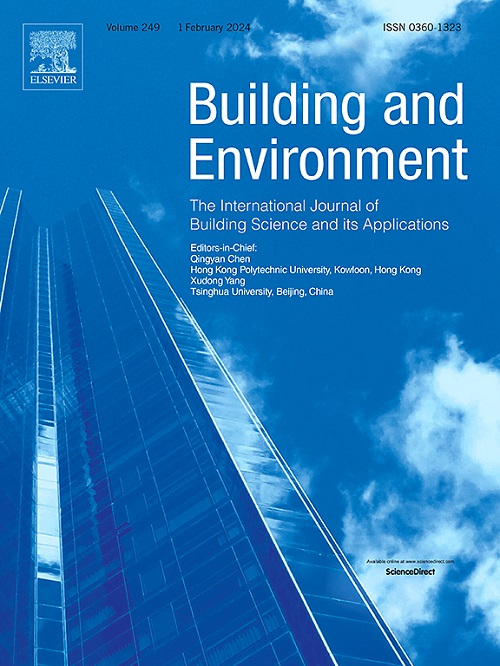排回风口与送风口隔离的送风动量驱动分层热环境的能效机制
IF 7.6
1区 工程技术
Q1 CONSTRUCTION & BUILDING TECHNOLOGY
引用次数: 0
摘要
采用高温和低温空气分别作为排风和回风的排回风解耦策略,可以有效降低热浮力驱动分层热环境的冷负荷。而对于另一种分层热环境,即以地层通风为代表的供给动量驱动的分层热环境,则不存在排回风解耦策略。本研究使用经过实验验证的CFD模拟来研究在供应动量驱动的分层热环境中所提出的解耦策略的能源效率背后的机制。根据地层通风的热分层特点,提出的解耦策略将排风口和回风口分别置于送风风口的上方和下方。揭示了解耦策略的节能机制,并与两种典型的地层通风耦合策略(上层耦合策略和下层耦合策略,排回风共用通风口分别位于送风通风口的上方和下方)进行了比较。结果表明,解耦策略对能效的影响主要有两种机制:1)积极机制是降低回风温度相对于排风温度,降低回风冷负荷;2)上排气孔的负机构将送风向上拉至空区,降低送风效率。在机构操纵下,与上下耦合策略相比,解耦策略分别节能30.7%和21.3%。本文章由计算机程序翻译,如有差异,请以英文原文为准。
Mechanisms of energy efficiency of supply momentum-driven stratified thermal environment with exhaust and return vents isolated by supply vent
The exhaust-return air decoupled strategy using high-temperature and low-temperature air as exhaust and return air, respectively, can effectively reduce the cooling load of the thermal buoyancy-driven stratified thermal environment. However, there is no exhaust-return air decoupled strategy for the other type of stratified thermal environments, i.e., the supply momentum-driven stratified thermal environment represented by stratum ventilation. This study uses experimentally validated CFD simulations to investigate the mechanisms behind the energy efficiency of the proposed decoupled strategy for the supply momentum-driven stratified thermal environment. According to the thermal stratification characteristics of stratum ventilation, the proposed decoupled strategy positions the exhaust and return vents above and below the supply vent, respectively. The mechanisms of energy efficiency due to the decoupled strategy are revealed and compared with two typical coupled strategies of stratum ventilation (the upper coupled strategy and the lower coupled strategy with the shared vents of the exhaust and return air located above and below the supply vent, respectively). The results show that the decoupled strategy has two major mechanisms impacting energy efficiency, i.e., 1) the positive mechanism lowers the return air temperature relative to the exhaust air temperature to reduce the cooling load of the return air; and 2) the negative mechanism with the upper vent drags the supply air up to the unoccupied zone, lowering air supply efficiency. With mechanism manipulation, the decoupled strategy saves energy by 30.7% and 21.3% compared with the upper and lower coupled strategies, respectively.
求助全文
通过发布文献求助,成功后即可免费获取论文全文。
去求助
来源期刊

Building and Environment
工程技术-工程:环境
CiteScore
12.50
自引率
23.00%
发文量
1130
审稿时长
27 days
期刊介绍:
Building and Environment, an international journal, is dedicated to publishing original research papers, comprehensive review articles, editorials, and short communications in the fields of building science, urban physics, and human interaction with the indoor and outdoor built environment. The journal emphasizes innovative technologies and knowledge verified through measurement and analysis. It covers environmental performance across various spatial scales, from cities and communities to buildings and systems, fostering collaborative, multi-disciplinary research with broader significance.
 求助内容:
求助内容: 应助结果提醒方式:
应助结果提醒方式:


